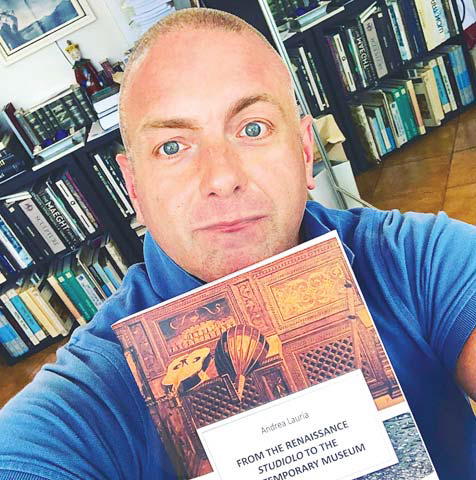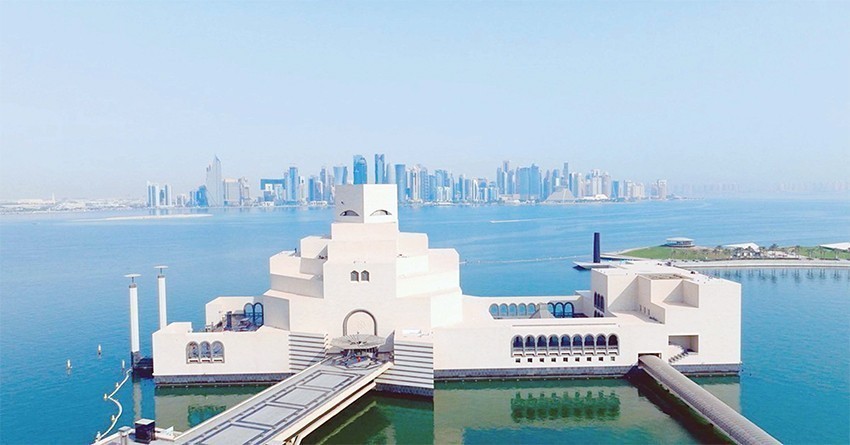27/04/2023
27/04/2023
Prof. Andrea Lauria is an Italian museologist graduated from Rome’s Accademy of fine arts. He also holds a History of Art degree from University di Roma Tre in Rome. Andrea Lauria lectures a Masters course in museology at Rome’s Universities Tor Vergata and American Temple University (Rome Campus). In 2020 he has become a published author of the book: “From the Renaissance studiolo to the contemporary museum” which is also his course manual. Lauria’s field of research is the phenomenon of hyper-museums with special attention to the Arabian countries in comparison with the western world.

The Museum of Islamic Art (MIA) which is located in Doha, Qatar is very important for two reasons -- the first reason is because the building was designed by an important 20th century archi-star the Chinese-American Leoh Ming Pei and the second reason is because it offers an interesting focus on Islamic art, unique of its kind. The collection in the museum has an enormous historical-artistic value and exhibits objects dated back from the 7th to the 19th century.

The MIA was established in 2008, and as I said it was designed by Chinese-American internationally renowned architect Leoh Ming Pei, an icon for us museographers and for all those involved in museums studies. Pei has designed the Pyramid of the Louvre in Paris, a project that makes him an important figure of the contemporary museography and the evolution of the museums’ architecture of 20th and 21st centuries.
The Louvre Pyramid is a large glass and metal structure in the main courtyard (Cour Napoléon) of the Louvre Palace in Paris. The large Pyramid, surrounded by three smaller pyramids, serves as the main entrance to the Louvre Museum. Completed in 1988, the Pei’s Louvre Pyramid has not only revolutionized and modernized the important French museum institution but it has become a landmark of the city of Paris. Occupying an area of 45,000 square meters (480,000 sq ft), the MIA location in Doha is stunning. The museum is located on an artificial peninsula overlooking the south end of Doha Bay and next to the traditional dhow -- the traditional Arab sailing boats with one or more lateen sails typical of the coasts of the Arabian Peninsula, harbor. The museum seems to be suspended over the sea with an almost magical effect. Its design is very intriguing; it is influenced by ancient Islamic architecture with geometric patterns, but with a contemporary interpretation. As a museum dedicated to Islamic art it is certainly unique museum in the Arab States of the Arabian Gulf.
The museum’s main building consists of the five fl oors, the main dome, and the central tower. It is connected with the education ward via a large central court. The building impresses with its brilliance which is due to the use of the outer facades, of the creamy limestone that is emphasized with its various shades during the different times of the day. The museum’s five floors are covered by a glass facade to the north, and it provides an amazing panoramic view of the Arabian Gulf. The architect, at that time 91 years old, traveled throughout many Islamic countries to learn about Muslim architecture and history and read many Islamic texts to draw inspiration for the museum’s design.
According to Pei, the light fountain in 9th century Ibn Tulun Mosque of Cairo was his final design inspiration. Many elements found in Ibn Tulun Mosque are represented in the building as an abstract form. The interior gallery spaces were designed by a team of Wilmotte Associates, the same Pei’s collaborator on the Louvre Paris project. The museum’s interior is decorated by several Islamic arts, a curved double staircase, at the center of the atrium that leads up to the first fl oor, and the large metallic chandelier over the lobby. Those choices enable the agreement with the principles of the postmodern architecture trend which synchronize the modernity and the traditional Islamic architectural identity. The museum is an intriguing mix of 21st century architecture and Islamic traditional art.
The MIA houses masterpieces of Islamic art gathered since the late 1980s including manuscripts, textiles and ceramics. As I said before the collection is huge, important because it represents Islamic art from three continents over 1,400 years and it is one of the world’s most complete collections of Islamic artifacts. These works come from both the secular and religious spheres with items originating in Spain, Egypt, Iran, Iraq, Turkey, India, and Central Asia. MIA’s collection includes metal work, ceramics, jewelry, wood work, textiles, and glass obtained from three continents and dating from the 7th to the 20th century.
The MIA’s manuscripts collection is very important, it includes more than 800 manuscripts from Qur’ans dating from the 7th century to Ottoman works of the 19th century. The museum hosts the restaurant and a library that has nine study rooms, and provides information about Islamic Arts in both Arabic and English. Adjacent to the museum is the beautiful MIA Park, a waterfront open space administered by the museum. The park surrounds the museum on the eastern and southern facades while two bridges connect the southern front facade of the property with the main peninsula that holds the park. It features cafes, a children’s play area, and a vertical steel sculpture by American sculptor Richard Serra located a short walk along the promenade from the MIA. Serra is known for his large-scale sculptures made for site-specific landscape, urban, and architectural settings. MIA Park, open 24 hours a day, offers year-round attractions, including film screenings, sporting events, outdoor cafés, art workshops, pop-up markets and more. In my column “From Italy to the world” I have already talked about Qatar in my article on the National Museum of Qatar, the spectacular work of Jean Nouvel.
The development of Qatari museography is very interesting, as the leadership of Sheikha Mayassa Bint Al Hamad Bin Khalifa Al Thani, and shows us how much this country invests in museums as well as in art and culture. The Islamic art museum in Doha, designed by the Archi star Ieoh Ming Pei, one of the most important architects for the renewal of museography in the 20th and 21st centuries, shows us the Qatari vision on museography of 21st century. Many Gulf countries have invested in hyper-museums in the last years but if we think that MIA museum was established in 2008, several years before the hyper-museums in the other Gulf countries I wrote about in previous articles, we can understand how Qatar understood much earlier the cultural, economic and political potential of the hyper-museums By Andrea Lauria


